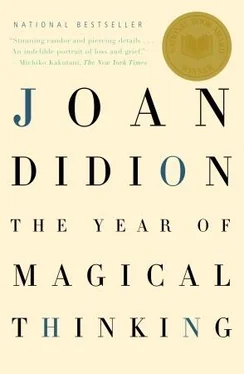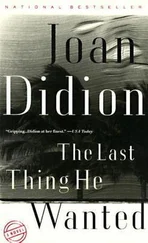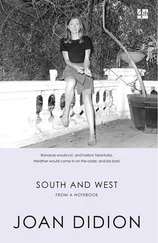1 ...6 7 8 10 11 12 ...35 “‘A night of memories and sighs,’” I remembered the lecturer repeating. “ A night. One night. It might be all night but he doesn’t even say all night, he says a night, not a matter of a lifetime, a matter of some hours.”
Hard sweet wisdom. Clearly, since “Rose Aylmer” had remained embedded in my memory, I believed it as an undergraduate to offer a lesson for survival.
December 30, 2003.
We had seen Quintana in the sixth-floor ICU at Beth Israel North.
Where she would remain for another twenty-four days.
Unusual dependency (is that a way of saying “marriage”? “husband and wife”? “mother and child”? “nuclear family”?) is not the only situation in which complicated or pathological grief can occur. Another, I read in the literature, is one in which the grieving process is interrupted by “circumstantial factors,” say by “a delay in the funeral,” or by “an illness or second death in the family.” I read an explanation, by Vamik D. Volkan, M.D., a professor of psychiatry at the University of Virginia in Charlottesville, of what he called “re-grief therapy,” a technique developed at the University of Virginia for the treatment of “established pathological mourners.” In such therapy, according to Dr. Volkan, a point occurs at which:
we help the patient to review the circumstances of the death — how it occurred, the patient’s reaction to the news and to viewing the body, the events of the funeral, etc. Anger usually appears at this point if the therapy is going well; it is at first diffused, then directed toward others, and finally directed toward the dead. Abreactions — what Bibring [E. Bibring, 1954, “Psychoanalysis and the Dynamic Psychotherapies,” Journal of the American Psychoanalytic Association 2:745 ff.] calls “emotional reliving”—may then take place and demonstrate to the patient the actuality of his repressed impulses. Using our understanding of the psychodynamics involved in the patient’s need to keep the lost one alive, we can then explain and interpret the relationship that had existed between the patient and the one who died.
But from where exactly did Dr. Volkan and his team in Charlottesville derive their unique understanding of “the psychodynamics involved in the patient’s need to keep the lost one alive,” their special ability to “explain and interpret the relationship that had existed between the patient and the one who died”? Were you watching Tenko with me and “the lost one” in Brentwood Park, did you go to dinner with us at Morton’s? Were you with me and “the one who died” at Punchbowl in Honolulu four months before it happened? Did you gather up plumeria blossoms with us and drop them on the graves of the unknown dead from Pearl Harbor? Did you catch cold with us in the rain at the Jardin du Ranelagh in Paris a month before it happened? Did you skip the Monets with us and go to lunch at Conti? Were you with us when we left Conti and bought the thermometer, were you sitting on our bed at the Bristol when neither of us could figure how to convert the thermometer’s centigrade reading into Fahrenheit?
Were you there?
No.
You might have been useful with the thermometer but you were not there.
I don’t need to “review the circumstances of the death.” I was there.
I didn’t get “the news,” I didn’t “view” the body. I was there.
I catch myself, I stop.
I realize that I am directing irrational anger toward the entirely unknown Dr. Volkan in Charlottesville.
Persons under the shock of genuine affliction are not only upset mentally but are all unbalanced physically. No matter how calm and controlled they seemingly may be, no one can under such circumstances be normal. Their disturbed circulation makes them cold, their distress makes them unstrung, sleepless. Persons they normally like, they often turn from. No one should ever be forced upon those in grief, and all over-emotional people, no matter how near or dear, should be barred absolutely. Although the knowledge that their friends love them and sorrow for them is a great solace, the nearest afflicted must be protected from any one or anything which is likely to overstrain nerves already at the threatening point, and none have the right to feel hurt if they are told they can neither be of use or be received. At such a time, to some people companionship is a comfort, others shrink from their dearest friends.
That passage is from Emily Post’s 1922 book of etiquette, Chapter XXIV, “Funerals,” which takes the reader from the moment of death (“As soon as death occurs, someone, the trained nurse usually, draws the blinds in the sick-room and tells a servant to draw all the blinds of the house”) through seating instructions for those who attend the funeral: “Enter the church as quietly as possible, and as there are no ushers at a funeral, seat yourself where you approximately belong. Only a very intimate friend should take a position far up on the center aisle. If you are merely an acquaintance you should sit inconspicuously in the rear somewhere, unless the funeral is very small and the church big, in which case you may sit on the end seat of the center aisle toward the back.”
This tone, one of unfailing specificity, never flags. The emphasis remains on the practical. The bereaved must be urged to “sit in a sunny room,” preferably one with an open fire. Food, but “very little food,” may be offered on a tray: tea, coffee, bouillon, a little thin toast, a poached egg. Milk, but only heated milk: “Cold milk is bad for someone who is already over-chilled.” As for further nourishment, “The cook may suggest something that appeals usually to their taste — but very little should be offered at a time, for although the stomach may be empty, the palate rejects the thought of food, and digestion is never in best order.” The mourner is prompted to practice economy as he or she accommodates the wearing of mourning: most existing garments, including leather shoes and straw hats, will “dye perfectly.” Undertaking expenses should be checked in advance. A friend should be left in charge of the house during the funeral. The friend should see that the house is aired and displaced furniture put back where it belongs and a fire lit for the homecoming of the family. “It is also well to prepare a little hot tea or broth,” Mrs. Post advised, “and it should be brought them upon their return without their being asked if they would care for it. Those who are in great distress want no food, but if it is handed to them, they will mechanically take it, and something warm to start digestion and stimulate impaired circulation is what they most need.”
There was something arresting about the matter-of-fact wisdom here, the instinctive understanding of the physiological disruptions (“changes in the endocrine, immune, autonomic nervous, and cardiovascular systems”) later catalogued by the Institute of Medicine. I am unsure what prompted me to look up Emily Post’s 1922 book of etiquette (I would guess some memory of my mother, who had given me a copy to read when we were snowbound in a four-room rented house in Colorado Springs during World War Two), but when I found it on the Internet it spoke to me directly. As I read it I remembered how cold I had been at New York Hospital on the night John died. I had thought I was cold because it was December 30 and I had come to the hospital bare-legged, in slippers, wearing only the linen skirt and sweater into which I had changed to get dinner. This was part of it, but I was also cold because nothing in my body was working as it should.
Mrs. Post would have understood that. She wrote in a world in which mourning was still recognized, allowed, not hidden from view. Philippe Ariès, in a series of lectures he delivered at Johns Hopkins in 1973 and later published as Western Attitudes toward Death: From the Middle Ages to the Present, noted that beginning about 1930 there had been in most Western countries and particularly in the United States a revolution in accepted attitudes toward death. “Death,” he wrote, “so omnipresent in the past that it was familiar, would be effaced, would disappear. It would become shameful and forbidden.” The English social anthropologist Geoffrey Gorer, in his 1965 Death, Grief, and Mourning, had described this rejection of public mourning as a result of the increasing pressure of a new “ethical duty to enjoy oneself,” a novel “imperative to do nothing which might diminish the enjoyment of others.” In both England and the United States, he observed, the contemporary trend was “to treat mourning as morbid self-indulgence, and to give social admiration to the bereaved who hide their grief so fully that no one would guess anything had happened.”
Читать дальше
Конец ознакомительного отрывка
Купить книгу












